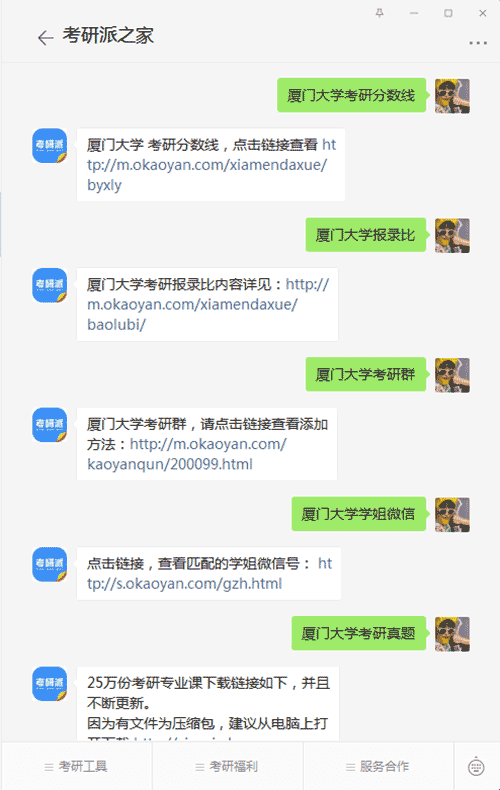
厦门大学材料学院导师:余兆菊的内容如下,更多考研资讯请关注我们考研派网站的更新!敬请收藏本站。或下载我们的考研派APP和考研派微信公众号(里面有非常多的免费考研资源可以领取哦)[厦门大学经济学院金融系导师:朱孟楠] [厦门大学经济学院金融系导师:郑荣鸣] [厦门大学经济学院金融系导师:林宝清] [厦门大学经济学院金融系导师:陈蓉] [厦门大学经济学院金融系导师:郑振龙] [厦门大学经济学院金融系导师:元惠萍]
为你答疑,送资源

95%的同学还阅读了: [2022厦门大学研究生招生目录] [厦门大学研究生分数线[2013-2021]] [厦门大学王牌专业排名] [厦门大学考研难吗] [厦门大学研究生院] [厦门大学考研群] [厦门大学研究生学费] 厦门大学保研夏令营 厦门大学考研调剂2022最新信息 [厦门大学研究生辅导] [考研国家线[2006-2021]] [2022年考研时间:报名日期和考试时间]
厦门大学材料学院导师:余兆菊正文
姓名:余兆菊
性别:女
职称:副教授
学院:材料学院
研究方向:有机硅功能高分子、生物医用高分子以及耐高温陶瓷材料金属有机先驱体的设计、合成与性能研究
教学领域:主讲本科生《高分子材料化学实验》和《基础化学实验二》课程,主讲硕士生、博士生学位课《高分子合成与分子设计》、工程硕士的《高分子性能表征与测试》及《功能高分子及其性能》课程。
招生:可提供良好的学习与科研条件,每年拟招本科毕业生(毕业论文)2-3人,硕士研究生1-2人,欢迎硕-博连读生。
联系电话: 0592-2181898
电子信箱: zhaojuyu@xmu.edu.cn
个人简介
余兆菊,博士,副教授,硕士生导师。主持国家自然科学基金(青年基金)、“十一五”重点项目一级子课题、福建省自然科学基金以及航空科学基金。作为主要技术骨干参与了“十五”和 “十一五”重点项目、国家自然科学基金重点项目、国家自然科学基金面上项目、福建省陶瓷重大专项、福建省重大科技项目、福建省重点课题等多项省部级以上课题。主要研究方向包括有机硅功能高分子、生物医用高分子以及耐高温陶瓷材料有机先驱体的设计、合成与性能研究。
工作经历
厦门大学副教授(2007- )
厦门大学讲师(2004-2007)
教育经历
2001-2004,武汉大学高分子化学与物理专业理学博士
1999-2001,武汉大学高分子化学与物理专业理学硕士
科研成果
学术专著与论文
1.“Preparation of a liquid boron-modified polycarbosilane and its ceramic conversion to dense SiC ceramics”,Polymers for advanced technologies,DOI 10.1002/pat.1777.
2.“Preparation of hyperbranched polycarbosilane precursor to SiC ceramics following an efficient room temperature cross-linking process.”Journal of Materials Science,2010,45,6151-6158.
3.“Modification of a liquid polycarbosilane with 9-BBN as a high-ceramic-yield precursor for SiC.”Reactive & Functional Polymers,2010,70,334-339.
4.“Preparation and characterization of cellulose and konjac glucomannan blend film from ionic liquid.”Journal of Polymer Science: Part B: Polymer Physics, 2009, 47, 1686-1694.
5.“Synthesis and Properties of Liquid Polycarbosilanes with Hyperbranched Structures”,Journal of Applied Polymer Science,2009,113(3),1611-1618.
6.“Effect of Curing and Pyrolysis Processing on the Ceramic Yield
of a Highly Branched Polycarbosilane”,Jounal of Materials Science,2009,44,721-725.
7.“Synthesis, Characterization and Pyrolytic Conversion of a Novel Liquid Polycarbosilane”,Journal of the American Ceramic Society,2008,91(10),3298-3302.
8.“Polymer-ceramic conversion of a highly branched liquid polycarbosilane for SiC-based ceramics”,Journal of Materials Science, 2008, 43, 2806-2811.
9.“Effect of the polycarbosilane structure on its final ceramic yield”, Journal of the European Ceramic Society, 2008, 28, 887-891.
10.“One-pot synthesis and characterization of a new, branched polycarbosilane bearing allyl groups”, Chinese Chemical Letters, 2007, 18 (6), 754-757.
11.“Microwave synthesis of poly (vinyl alcohol)–graft -poly(ε-caprolactone) copolymers”, Polymer Prepint,2007, 48 (1), 451-452.
12.“Microwave synthesis of star-shaped poly(ε-caprolactone) with polyol initiator”, Abstracts of Papers of American Chemical Society, 2007, 233,PMSE-372.
13.“Microwave-assisted synthesis of poly(ε-caprolactone)-poly(ethylene glycol)-poly(ε-caprolactone) tri-block co-polymers and use as matrices for sustained delivery of ibuprofen taken as model drug”,Journal of Biomaterials Science Polymer Edition, 2005, 16 (8), 957-971.
14.“Effect of microwave energy on chain propagation of poly(ε-caprolactone) in benzoic acid-initiated ring opening polymerization of ε-caprolactone”,European Polymer Journal, 2004, 40 (9), 2213-2220.
15.“Dye-molecular- imprinted polysiloxanes. II. Preparation, characterization and recognition behavior”, Journal of Applied Polymer Science, 2004, 93(2), 637-643.
16.“Microwave synthesis of PCL/PEG/PCL triblock copolymers and drug release system thereof”, Transactions - 7th World Biomaterials Congress, 2004, 672.
17.“Microwave-improved polymerization of ε-caprolactone initiated by carboxylic acids”,Journal of Polymer Science Part A: Polymer chemistry, 2003, 41, 13-21.
18.“Microwave irradiation effect on the polymerization of ε-caprolactone with benzoic acid as initiator”,Polym. Prepr., 2003, 44(1), 868-869.
19.“Microwave-assisted synthesis of poly(ε-caprolactone) with acid as initiator and a novel method in preparation drug release systems”, Polym. Prepr., 2003, 44(1), 936-937.
20. “偶氮二异丁腈引发液态聚碳硅烷的交联研究”,硅酸盐学报,2009,37(8), 105-109。
21. “过氧化苯甲酰在液态聚碳硅烷交联中的应用”,功能材料,2009,40,2058-2060。
22.“液态超支化聚碳硅烷的研究进展”,功能材料,2010,41,1113-1116。
23.“低氧含量液态超支化聚碳硅烷的合成与陶瓷化研究”,功能材料,2010,在印中。
24.国家发明专利,ZL-02-1-15944.0。
25.国防发明专利,200510134835.7。
26.国防发明专利,200710080437.0。
27.国防发明专利,200810075333.5
28.国防发明专利,201010047184.9
29.国防发明专利,201010047183.4
添加厦门大学学姐微信,或微信搜索公众号“考研派之家”,关注【考研派之家】微信公众号,在考研派之家微信号输入【厦门大学考研分数线、厦门大学报录比、厦门大学考研群、厦门大学学姐微信、厦门大学考研真题、厦门大学专业目录、厦门大学排名、厦门大学保研、厦门大学公众号、厦门大学研究生招生)】即可在手机上查看相对应厦门大学考研信息或资源。


本文来源:http://m.okaoyan.com/xiamendaxue/daoshi_495580.html































